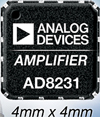

To meet the design needs of instrumentation and industrial equipment designers, Analog Devices has introduced a zero-drift, digitally-programmable instrumentation amplifier (in-amp). Rated over an extended industrial temperature range, it says the AD8231 is suited for a variety of sensors, including resistance temperature detectors, thermocouples and automotive pressure sensors, in harsh environments where minute signal variations must be accurately detected in the presence of large common-mode voltages.
The company claims the AD8231 features 80% lower input noise than industry standard devices while delivering rail-to-rail inputs and outputs at up to 1 MHz bandwidth - five times the throughput of the nearest competing zero-drift in-amp. It adds that the device's exceptionally low noise characteristics allow designers of industrial sensors and controls to maintain DC precision over gain.
"Zero-drift instrumentation amplifiers can have high noise at high gains for a variety of reasons, including the presence of chopping noise," said Steve Sockolov, product line director at Analog Devices. "However, the trade-off between offset drift and noise becomes untenable as the gain increases to the level demanded by today's industrial equipment manufacturers. Analog Devices addressed this challenge using a proprietary auto-zero technique that dramatically lowers the in-amp's noise profile while eliminating the need for external components, such as switched capacitors."
Using a three-op-amp instrumentation architecture, the AD8231 enhances reliability by integrating auto-zero amplifiers to maintain a voltage offset of only 50 nV°C across temperature and over years of operation. It has internal gain-setting resistors, which limit gain coefficient temperature drift to 10 ppm/°C. ADI chose the LFCSP (lead-frame chip-scale package) material for its reliability and robustness over temperature, which results in a part that is specified from -40 to 125°C. The package comes with a centre paddle, to keep the part securely soldered in high-vibration environments.
Software programmability eases gain adjustment
The AD8231 features software programmable gains of 1, 2, 4, 8, 16, 32, 64, or 128, which are programmed through a three-pin interface. The gain can be set using digital logic, which allows users to repeatedly adjust gain once in system. A pin-strapping gain setting option is also included. The device operates on a single supply from 3,3 V to 5 V and has rail-to-rail outputs, making it easy to interface to an ADC. Because of its high impedance input of 10 gigaΩ, it does not suffer performance degradation when using higher impedance sensors.
Design flexibility yields savings
The AD8231 includes an additional on-chip op-amp, which further extends performance. The op-amp can be used to create a differential output to drive modern high performance ADCs, or to add or customise gains. The integrated op-amp also provides a tool for additional error correction, level shifting, or filtering. Using the same low-noise auto-zero techniques as the in-amp, the on-chip op-amp also has rail-to-rail inputs and outputs. The ability of the AD8231 to eliminate noise-prone discrete components, such as switched capacitors, and with the added on-chip signal conditioning of the integrated op-amp, cuts cost by 60% and reduces the board space required by 50% compared to other zero-drift in-amps, according to ADI.
The part is manufactured with ADI's iCMOS (industrial CMOS) process technology, allowing it to achieve a noise level of 32 nV/rt-Hz. It also features 122-dB CMR (common-mode rejection), allowing the in-amp to detect very low-amplitude signals in noisy environments.
Analog Device’s new single-supply in-amp easily interfaces to ADCs and microcontrollers by using the same power supply as digital components. It is designed to work with the company's range of data converters, precision analog microcontrollers and its voltage reference ICs.

© Technews Publishing (Pty) Ltd | All Rights Reserved